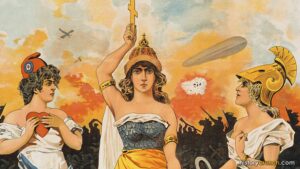The atomic bombing of Japan by the United States at the end of World War II is one of the most controversial events in all of world history. World War II ended in Europe by May of 1945 with the defeat of Nazi Germany by the Allied Powers, but the war did not officially end in the Pacific Theater until the atomic bombing of Japan in August of 1945. The United States had developed its atomic weaponry through its secretive program called the Manhattan Project.
ATOMIC BOMBING OF JAPAN – SUMMARY
The first atomic bomb dropped on Japan was codenamed Little Boy and was detonated over the city of Hiroshima on August 6th, 1945. Hiroshima is a city on the largest island of Japan and had a population of over 400,000 at the time of the atomic bombing. The atomic bomb was carried to its target by an American B-29 bomber called the Enola Gay after United States President, Harry S. Truman, approved its use against Japan.
The city of Nagasaki was located in the south east of Japan and had approximately 240,000 people. The atomic bomb used against Nagasaki was called the Fat Man and was delivered to the city on August 9th by the American B-29 bomber Bockscar.
Japan’s surrender was announced on August 15th, and World War II in the Pacific was over. The formal surrender of Japan would occur on September 2nd, 1945 aboard the United States battleship USS Missouri. There, Japanese officials signed the official Instrument of Surrender.
The atomic bombing of Japan by the United States in 1945 is one of the most controversial events in all of world history and many have argued both in favor of using the weapon and against using it in order to end World War II. Regardless, the atomic bombing is a significant event for its role in ending World War II and for the impact it would have on all future warfare. Click here for more detailed information on the two atomic bombs used against Japan at the end of the World War II.
ATOMIC BOMBING OF JAPAN – REASONS FOR
Some historians have argued that the atomic bombing of Japan at the end of World War II was necessary and justified. There have been several key reasons developed to support this position, such as:
- It led to a quick end to World War II.
- It saved the lives of American soldiers.
- It potentially saved the lives of Japanese soldiers and civilians.
- It forced Japan to surrender, which it appeared unwilling to do.
- It was revenge for Japan’s attack at Pearl Harbor.
- It matched the brutality that Japan used during the war.
- Japan was warned about the potential of the atomic bombs.
- The program to create the bombs was too expensive for them not to be used.
- Bombs are a natural part of war.
- It was necessary as a display for the emerging Cold War.
The above is a general list of reasons in favor of the use of the atomic bombs. Click here for more detailed reasons on why the United States was justified in using the atomic bombs against Japan.
ATOMIC BOMBING OF JAPAN – REASONS AGAINST
Although some historians were in favor of the use of the atomic bombs, many others have argued that the atomic bombing of Japan at the end of World War II was not necessary and unjustified. There have been several key reasons developed to support this position, such as:
- It was inhumane.
- It caused too much destruction.
- It killed too many innocent people, including children.
- It was unnecessary as Japan was essentially defeated.
- Japan was seeking surrender.
- It was not universally supported in the United States.
- The United States could have done something else.
- The United States should have waited longer between the two bombs.
- It was used more to scare the Soviet Union than to defeat Japan.
- It led to the modern atomic age and the threat of nuclear warfare.
The above is a general list against the use of the atomic bombs in World War II. Click here for more detailed reasons on why the United States was not justified in using the atomic bombs against Japan.

